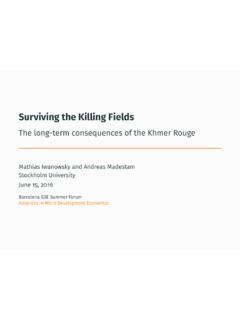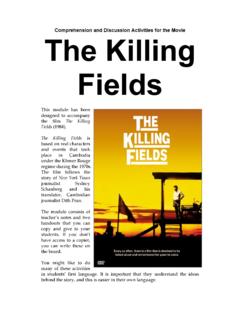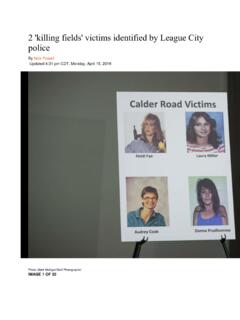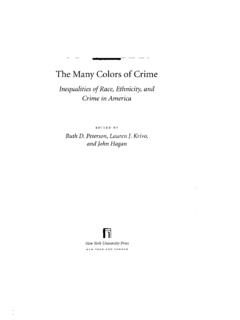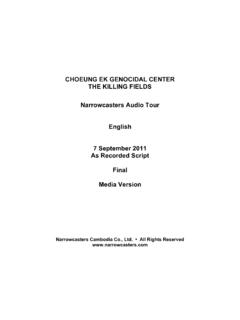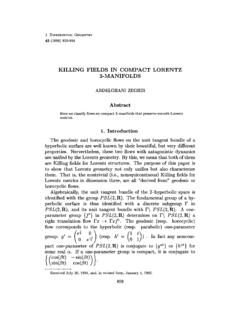Transcription of The Killing Fields, Ethnic Cleansing and Genocide in Europe ...
1 The Killing Fields, Ethnic Cleansing and Genocide in Europe : Yugoslavia as a Case Study by Hal Elliott Wert The Bloodlands: An Historical Overiew Ian Kershaw, in The End: The Defiance and Destruction of Hitler's Germany, 1944-1945, recounts in great detail the horrific slaughter accompanying the end of the World War II in Europe , a tale told as well by Antony Beevor, Richard J. Evans, Max Hastings, and David Stafford, among Timothy Snyder in Bloodlands, a groundbreaking book about the atrocities committed by Stalin and Hitler between the World Wars and during World War II, broadens the perspective and the time frame. An especially forceful chapter recounts the massive Ethnic Cleansing of Germans and other Ethnic groups that occurred near the end of that war under the auspices of the Soviet Red Army in order to establish ethnically pure nation states, for example, Poles in Poland, Ukrainians in the Soviet Ukraine, and Germans in a truncated The era of Stalin and Hitler was captured in the lyrics of a hit song recorded by Leonard Cohen entitled The Future: The blizzard of the world has crossed the threshold, I see the future brother it is murder.
2 For millions in Stalin's grasp the truth of Marxist dialectics was brought home to them by the cold steel barrel of a pistol that parted the hair on the back of their heads. Momentarily each of those millions understood the meaning of being on the wrong side of history as they were rounded up, executed, and buried in mass unmarked graves just for being a member of a despised Ethnic group. For millions of others in the clutches of the Nazis a similar fate awaited them. The men of Reserve Police Battalion 101, struggling with their atrocities, absurdly rationalized that it is more humane to shoot children after shooting their mothers lest the children become orphans who would not Murder by both the Nazis and the Soviets was most often up close and Unlike Dr. Hal Wert has written extensively on Ethnic Cleansing in Europe and the Holocaust and has been a longtime member of the Holocaust Education Academic Round Table.
3 He is the author of Hoover the Fishing President: Portrait of the Private Man and His Life Outdoors and his book Hope: A Collection of Obama Posters and Prints was awarded a Benjamin Franklin Prize for the best book in politics/current affairs by the Independent Book Publishers Association in 2010. He earned a PhD from Kansas University and is currently a professor of history at the Kansas City Art Institute. 28 | Features InterAgency Journal Vol. 3, Issue 2, Special Edition Odysseus, the people of the Bloodlands could Europe that problems could be finally not steer a safe passage between the Scylla and solved by utopian revolutions a solution the that nearly guaranteed a calamitous outcome, Although histories of killings and Ethnic a persistence in thought despite historical Cleansing in Europe over the last several experience, that resulted in the triumph of logic hundred years abound, far too often these over The mass murder and rape reports suffer a particularistic approach that that unfolded in Yugoslavia is emblematic of only describes portions of what is a much wider what occurred generally throughout Central The Holocaust, for example, was and Eastern Europe beginning in the early not an anomaly.
4 Not some aberration thought up nineteenth by madmen, though Hitler and his ideological henchmen were surely mad. Importantly, the murder of millions in the middle of the last century does not stand outside European The mass murder and rape history or philosophy. For all of the glories that unfolded in Yugoslavia is and achievements of Europe , the dark side emblematic of what occurred Ethnic strife compounded by murder, supported generally throughout Central by a bevy of philosophies, ideologies, and and Eastern Europe beginning in intellectuals progressed unabated. The the early nineteenth century. calamity, a Danse Macabre as Franz Masereel portrayed in his startling woodcuts, was overseen by the best and the brightest. Killing and Ethnic Cleansing in Europe largely begins An Effort at Pluralism in the early nineteenth century and is tied to the rise of nationalism and the dissolution of Understanding the nightmarish war in the the Ottoman, Russian, Austro-Hungarian, and former Yugoslavia in the 1990s depends upon German an understanding of the complex and twisted Timothy Snyder's Bloodlands, is in reality history of the Balkans.
5 In fact the words, much larger than the area indicated on his Balkans and Balkanization have come introductory map. He intentionally focused his to mean baffling, convoluted, and perhaps study on portions of Central and Eastern Europe irresolvable. Churchill's characterization of and clearly revealed the problems involved in the Soviet Union as a riddle, wrapped in a the standard perception of Genocide under mystery, inside an enigma is just as apropos of Hitler and Insightful European leaders Southeastern But why does this area like Thomas Masaryk, the first President of the of Europe seem so inscrutable ? Unless we newly independent Czechoslovakia in 1919, attribute to its denizens special characteristics not understood this and bluntly remarked: Europe shared by others on the planet, the explanation is a laboratory built on a vast graveyard.
6 9 The is to be found in the details of Balkan history, further east and southeast you travel in Europe , not in the reductive myth of some ancient blood the deeper the strain of historical antecedents feud. Questions about the characteristics of of the European blood sport of Genocide . Yugoslavia and the Slavic culture are fascinating Traveling back in time still further one reaches in their complexity and a subset of the larger the Enlightenment and the conclusions that questions about characteristics of the European were drawn by some of the best minds in continent as a whole. Col. Arthur D. Simons Center for the Study of Interagency Cooperation, Fort Leavenworth, Kansas Features | 29. The Martyrs'. memorial cemetery Kova i in Sarajevo. photo by Michael B ker Framing answers to these questions break up Canada, and contributed to the breakup begins in early nineteenth century Europe , a of Yugoslavia, Czechoslovakia, Rwanda, and century swept by change.
7 Historical forces the former Soviet The momentous were unleashed by the Reformation, the Age changes that swept nineteenth century Europe of Enlightenment, the scientific revolution, the intertwined and were politically concentrated French revolution, the industrial revolution, the in the demands of the burgeoning middle class rise of capitalism, and the rise of the middle on an entrenched aristocracy. The bourgeoisie class. However, most importantly, romanticism, representing these changes were in greater especially German romanticism, tied irrational, numbers and more successful in Western Europe explosive ideas such as a people, the nation, the than in Eastern Europe . In Eastern Europe , the fatherland, a race, a religion, to the concept of ancient regimes, though weakened, prevailed, the Within liberal democratic capitalist and the result was uneven economic, political, states, two ideas surfaced to qualify individuals and cultural change Europe was divided.
8 It for membership in the state. One idea embraced is significant that within this historical climate open and inclusive pluralism, while the other a different form of nationalism developed in embraced exclusiveness and homogeneity different parts of Eastern based on race and ethnicity (ancestry, language, Many in Eastern Europe wanted the religion, history, tradition).14 The idea of economic prosperity and political freedom of pluralism prevailed in some modern states, but what the East Germans longingly termed the Germany and Japan's rejection of pluralism as Goldenen Westen. Germany and Italy, nations the basis of citizenship, coupled with their very that unified around language, culture, blood, success as modern states, ensured that other and geography, were powerful examples to states would attempt to follow their be emulated by Ethnic groups in multicultural The struggle between these two concepts empires and people, like the Poles, who continues to afflict many societies.
9 Following were trapped between or in several empires the fall of the Berlin Wall, the idea of race and simultaneously. If, however, ethnicity was the ethnicity gained momentum in the decentralized criterion for nationhood, then Eastern Europe 1990s. Witness the problems that repeatedly would be divided into a number of quite small trouble Belgium, have on occasion threatened to states and this in itself was a serious political and 30 | Features InterAgency Journal Vol. 3, Issue 2, Special Edition economic problem. Within the Austrian Empire, of Europe . The exception was the Balkans, Hungary demonstrated another path to partial where one of the three imperial players, the self-determination in which Magyars controlled Turkish Ottomans, was considerably weaker an empire within an empire. Hungarians achieved near equality with Austrians in the Dual Monarchy (1867-1918) and ruled over Poles, Slovaks, Ruthenians, Jews, Gypsies, In the nineteenth century, Muslim Slavs, Serbs, Slovenes, and after the Napoleonic Wars But neither in the more traditional Russian and the Congress of Vienna, and Turkish empires, nor in the new nations of power was reasonably balanced Germany and Italy, nor in the Austro-Hungarian throughout most of Europe .
10 Dual monarchy were these powers quiescent The exception was the Balkans, toward their neighbors in lands in between or where one of the three toward territories in other empires that they imperial players, the Turkish desired. Ambitious empires and ambitious Ottomans, was considerably new nations on their frontiers coveted those weaker than the other two. few remaining unabsorbed Eastern European people and their land. Two different phenomena drove this expansionism. The old empires sought to continue as they had in the past to than the other two. Turkey, often dubbed the hold on to what they already possessed and sick man of Europe , offered Russians and when possible to add new territory and peoples Austro-Hungarians tempting opportunities. In to their polyglot Other areas, notably 1878 the Austro-Hungarians, determined to Italy and Germany, were territories that rushed maintain great power status after their defeat to organize as nation states and then rushed to by the Prussians at K niggr tz in 1866, took become empires.


